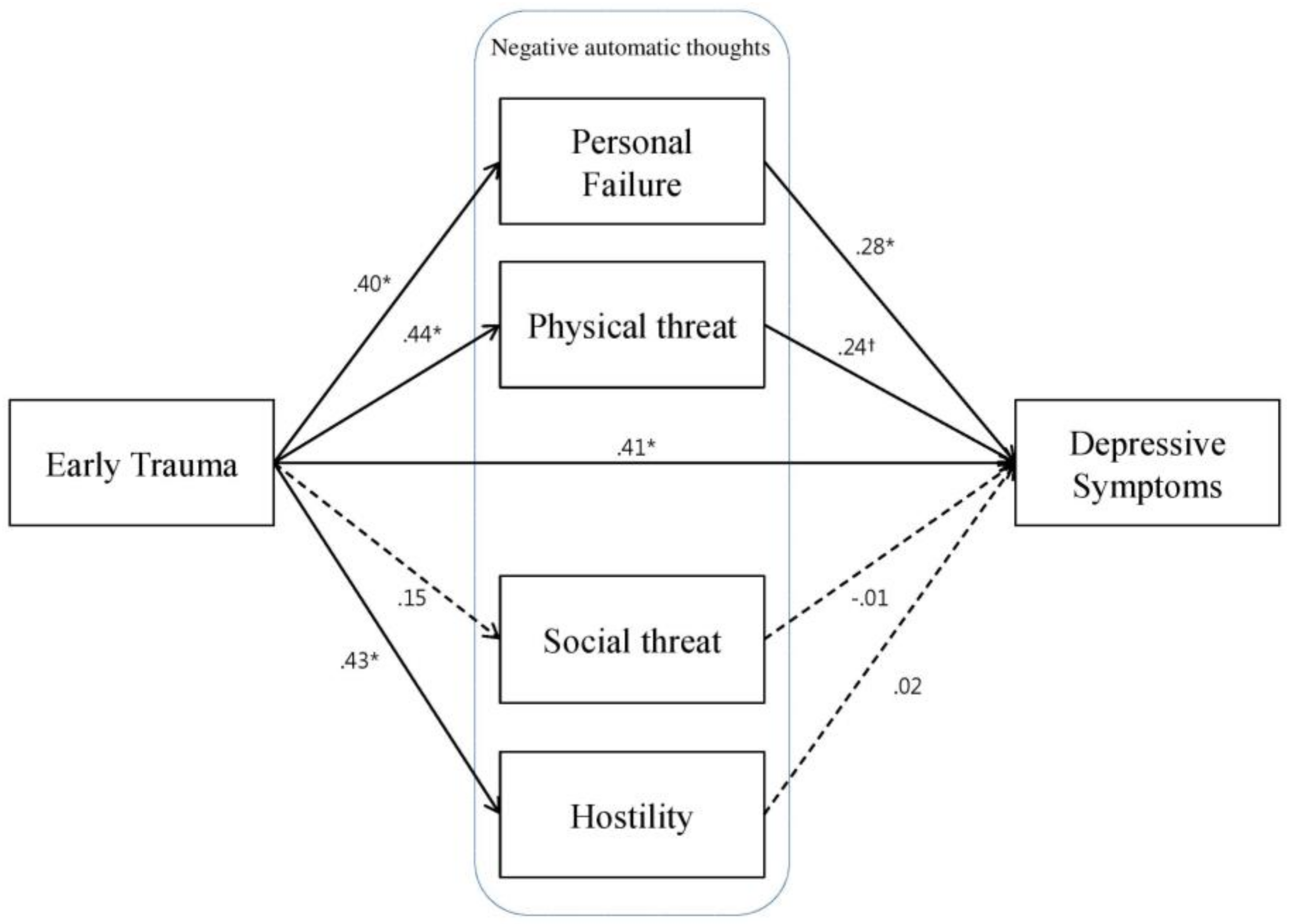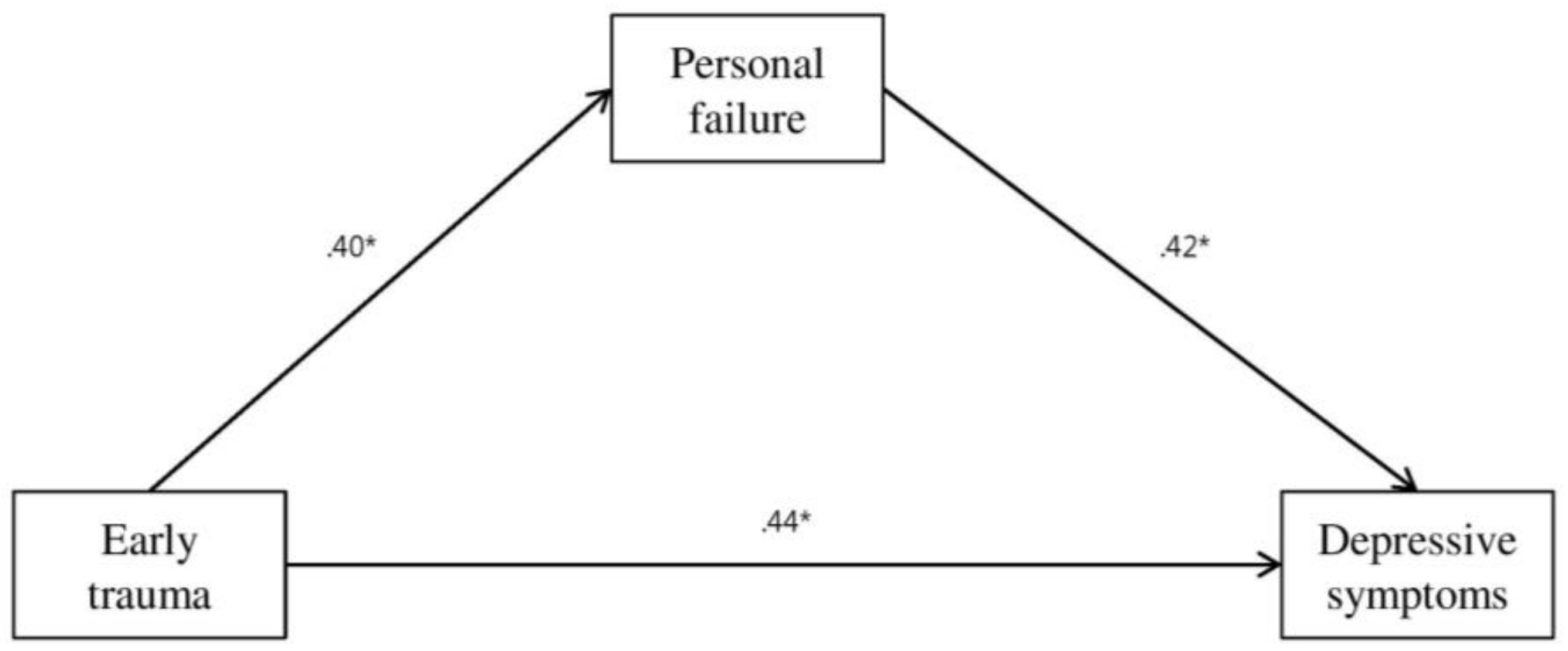Trauma and Depression among North Korean Refugees: The Mediating Effect of Negative Cognition
Abstract
:1. Introduction
2. Materials and Methods
2.1. Participants
2.2. Measures
2.3. Statistical Analysis
3. Results
4. Discussion
5. Conclusions
Acknowledgments
Author Contributions
Conflicts of Interest
References
- Jeon, W.T.; Yu, S.E.; Cho, Y.A.; Eom, J.S. Traumatic experiences and mental health of North Korean refugees in South Korea. Psychiatry Investig. 2008, 5, 213–220. [Google Scholar] [CrossRef] [PubMed]
- Jeon, W.; Min, S.; Lee, M.; Lee, E. A study on adaptation of North Koreans in South Korea. J. Korean Neuropsychiatr. Assoc. 1997, 36, 145–161. [Google Scholar]
- Nam, B.; Kim, J.Y.; DeVylder, J.E.; Song, A. Family functioning, resilience, and depression among North Korean refugees. Psychiatry Res. 2016, 245, 451–457. [Google Scholar] [CrossRef] [PubMed]
- Kim, Y.-H. Predictors for mental health problems among young North Korean refugees in South Korea. Contemp. Soc. Multicul. 2013, 3, 264–285. [Google Scholar]
- Choi, Y.; Lim, S.Y.; Jun, J.Y.; Lee, S.H.; Yoo, S.Y.; Kim, S.; Gwak, A.R.; Kim, J.-C.; Lee, Y.J.; Kim, S.J. The effect of traumatic experiences and psychiatric symptoms on the life satisfaction of North Korean refugees. Psychopathology 2017, 50, 203–210. [Google Scholar] [CrossRef] [PubMed]
- Park, J.; Jun, J.Y.; Lee, Y.J.; Kim, S.; Lee, S.H.; Yoo, S.Y.; Kim, S.J. The association between alexithymia and posttraumatic stress symptoms following multiple exposures to traumatic events in North Korean refugees. J. Psychosom. Res. 2015, 78, 77–81. [Google Scholar] [CrossRef] [PubMed]
- Kim, Y.J.; Cho, Y.A.; Kim, H.A. A mediation effect of ego resiliency between stresses and mental health of North Korean refugee youth in South Korea. Child Adolesc. Soc. Work J. 2015, 32, 481–490. [Google Scholar] [CrossRef]
- Emery, C.R.; Lee, J.Y.; Kang, C. Life after the pan and the fire: Depression, order, attachment, and the legacy of abuse among North Korean refugee youth and adolescent children of North Korean refugees. Child Abuse Negl. 2015, 45, 90–100. [Google Scholar] [CrossRef] [PubMed]
- Han, I.Y. Depressive traits of North Korean defectors. Ment. Health Soc. Work 2001, 11, 78–94. [Google Scholar]
- Kim, H.H.; Lee, Y.J.; Kim, H.K.; Kim, J.E.; Kim, S.J.; Bae, S.-M.; Cho, S.-J. Prevalence and correlates of psychiatric symptoms in North Korean defectors. Psychiatry Investig. 2011, 8, 179–185. [Google Scholar] [CrossRef] [PubMed]
- Beck, A.T. Cognitive models of depression. J. Cogn. Psychother. 1987, 1, 5–37. [Google Scholar]
- Seligman, M.E.P. Learned helplessness. Annu. Rev. Med. 1972, 23, 407–412. [Google Scholar] [CrossRef] [PubMed]
- Rose, D.T.; Abramson, L. Developmental predictors of depressive cognitive style: Research and theory. Dev. Perspect. Depress. 1992, 4, 323. [Google Scholar]
- Gibb, B.E. Childhood maltreatment and negative cognitive styles: A quantitative and qualitative review. Clin. Psychol. Rev. 2002, 22, 223–246. [Google Scholar] [CrossRef]
- Janoff-Bulman, R. Assumptive worlds and the stress of traumatic events: Applications of the schema construct. Soc. Cogn. 1989, 7, 113–136. [Google Scholar] [CrossRef]
- Beck, A.T.; Brown, B.; Steer, R.A.; Eidelson, J.I.; Riskind, J.H. Differentiating anxiety and depression utilizing the Cognition Checklist. J. Abnorm. Psychol. 1987, 96, 179–183. [Google Scholar] [CrossRef] [PubMed]
- Teasdale, J.D. Cognitive vulnerability to persistent depression. Cogn. Emotion. 1988, 2, 247–274. [Google Scholar] [CrossRef]
- Mathews, A.; MacLeod, C. Cognitive vulnerability to emotional disorders. Ann. Rev. Clin. Psychol. 2005, 1, 167–195. [Google Scholar] [CrossRef] [PubMed]
- Beck, A.T. Cognitive Therapy of the Emotional Disorders; New York American Library: New York, NY, USA, 1976. [Google Scholar]
- Beck, A.T.; Clark, D.A. Anxiety and depression: An information processing perspective. Anxiety Res. 1988, 1, 23–36. [Google Scholar] [CrossRef]
- Jolly, J.B.; Dyck, M.J.; Kramer, T.A.; Wherry, J.N. Integration of positive and negative affectivity and cognitive content-specificity: Improved discrimination of anxious and depressive symptoms. J. Abnorm. Psychol. 1994, 103, 544–552. [Google Scholar] [CrossRef] [PubMed]
- Clark, D.A.; Beck, A.T.; Brown, G. Cognitive mediation in general psychiatric outpatients: A test of the content-specificity hypothesis. J. Pers. Soc. Psychol. 1989, 56, 958–964. [Google Scholar] [CrossRef] [PubMed]
- Safren, S.A.; Heimberg, R.G.; Lerner, J.; Henin, A.; Warman, M.; Kendall, P.C. Differentiating anxious and depressive self-statements: Combined factor structure of the anxious self-statements questionnaire and the automatic thoughts questionnaire-revised. Cogn. Ther. Res. 2000, 24, 327–344. [Google Scholar] [CrossRef]
- Schniering, C.A.; Rapee, R.M. Development and validation of a measure of children’s automatic thoughts: The children’s automatic thoughts scale. Behav. Res. Ther. 2002, 40, 1091–1109. [Google Scholar] [CrossRef]
- Schniering, C.A.; Rapee, R.M. The structure of negative self-statements in children and adolescents: A confirmatory factor-analytic approach. J. Abnorm. Child Psychol. 2004, 32, 95–109. [Google Scholar] [CrossRef] [PubMed]
- Lee, Y.; Lee, M.; Park, S. Mental health status of North Korean refugees in South Korea and risk and protective factors: A 10-year review of the literature. Eur. J. Psychotraumatol. 2017, 8, 1369833. [Google Scholar] [CrossRef] [PubMed]
- Montgomery, E. Trauma, exile and mental health in young refugees. Acta Psychiatr. Scand. 2011, 124, 1–46. [Google Scholar] [CrossRef] [PubMed]
- Bremner, J.D.; Bolus, R.; Mayer, E.A. Psychometric properties of the Early Trauma Inventory-Self Report. J. Nerv. Ment. Dis. 2007, 195, 211–218. [Google Scholar] [CrossRef] [PubMed]
- Jeon, J.R.; Lee, E.H.; Lee, S.W.; Jeong, E.G.; Kim, J.H.; Lee, D.; Jeon, H.J. The early trauma inventory self report-short form: Psychometric properties of the Korean version. Psychiatry Investig. 2012, 9, 229–235. [Google Scholar] [CrossRef] [PubMed]
- Moon, H.; Oh, K.; Moon, H. Validation study of Korean Children’s Automatic Thoughts Scale. Korean J. Clin. Psychol. 2002, 21, 955–963. [Google Scholar]
- Cho, M.J.; Kim, K.H. Diagnostic validity of the CES-D (Korean version) in the assessment of DSM-III-R major depression. J. Korean Neuropsychiatr. Assoc. 1993, 32, 381–399. [Google Scholar]
- Cho, M.J.; Kim, K.H. Use of the Center for Epidemiologic Studies Depression (CES-D) Scale in Korea. J. Nerv. Ment. Dis. 1998, 186, 304–310. [Google Scholar] [CrossRef] [PubMed]
- Radloff, L.S. The CES-D scale: A self-report depression scale for research in the general population. Appl. Psychol. Meas. 1977, 1, 385–401. [Google Scholar] [CrossRef]
- Olobatuyi, M.E. A User’s Guide to Path Analysis; University Press of America: Lanham, MD, USA, 2006; p. 40. [Google Scholar]
- Lee, Y.-J.G.; Jun, J.Y.; Lee, Y.J.; Park, J.; Kim, S.; Lee, S.H.; Yu, S.Y.; Kim, S.J. Insomnia in North Korean refugees: Association with depression and post-traumatic stress symptoms. Psychiatry Investig. 2016, 13, 67–73. [Google Scholar] [CrossRef] [PubMed]
- Jeon, B.-H.; Kim, M.-D.; Hong, S.-C.; Kim, N.-R.; Lee, C.-I.; Kwak, Y.-S.; Park, J.-H.; Chung, J.; Chong, H.; Jwa, E.-K.; et al. Prevalence and correlates of depressive symptoms among North Korean defectors living in South Korea for more than one year. Psychiatry Investig. 2009, 6, 122–130. [Google Scholar] [CrossRef] [PubMed]
- Li, M.; D’Arcy, C.; Meng, X. Maltreatment in childhood substantially increases the risk of adult depression and anxiety in prospective cohort studies: Systematic review, meta-analysis, and proportional attributable fractions. Psychol. Med. 2015, 46, 717–730. [Google Scholar] [CrossRef] [PubMed]
- Nelson, J.; Klumparendt, A.; Doebler, P.; Ehring, T. Childhood maltreatment and characteristics of adult depression: Meta-analysis. Br. J. Psychiatry 2016. [Google Scholar] [CrossRef] [PubMed]
- Porter, M.; Haslam, N. Predisplacement and postdisplacement factors associated with mental health of refugees and internally displaced persons: A meta-analysis. JAMA 2005, 294, 602–612. [Google Scholar] [CrossRef] [PubMed]
- Steel, Z.; Chey, T.; Silove, D.; Marnane, C.; Bryant, R.A.; van Ommeren, M. Association of torture and other potentially traumatic events with mental health outcomes among populations exposed to mass conflict and displacement. JAMA 2009, 302, 537–549. [Google Scholar] [CrossRef] [PubMed]
- Park, S. Reliability and validity of the early trauma inventory self report-short form among Korean adolescents. J. Korean Acad. Child Adolesc. Psychiatry 2018, 29, 2–6. [Google Scholar] [CrossRef]
- Cho, Y.A.; Jeon, W.; Yu, J.J.; Um, J.-S. Predictors of depression among North Korean defectors: A 3-year follow-up study. Korean J. Couns. Psychother. 2005, 17, 467–484. [Google Scholar]
- Korea Hana Foundation. Survey on Social Integration of North Korean Defectors; Korea Hana Foundation: Seoul, Korea, 2017. [Google Scholar]
- Beck, A.T. Prisoners of Hate: The Cognitive Basis of Anger, Hostility, and Violence; HarperCollins: New York, NY, USA, 1999. [Google Scholar]
- Kim, Y. Posttraumatic stress disorder as a mediator between trauma exposure and comorbid mental health conditions in North Korean refugee youth resettled in South Korea. J. Interpers. Violence 2014, 31, 425–443. [Google Scholar] [CrossRef] [PubMed]
- Fiedler, K.; Harris, C.; Schott, M. Unwarranted inferences from statistical mediation tests—An analysis of articles published in 2015. J. Exp. Soc. Psychol. 2018, 75, 95–102. [Google Scholar] [CrossRef]


| Item | Frequency (%) |
|---|---|
| General trauma | 76.1 |
| T1. Natural disaster | 10.1 |
| T2. Serious accident | 20.2 |
| T3. Serious personal injury | 27.5 |
| T4. Serious injury/ illness of parent | 22.0 |
| T5. Separation of parents | 43.1 |
| T6. Serious illness/injury of sibling | 10.1 |
| T7. Serious injury of friend | 14.7 |
| T8. Witnessing violence | 34.9 |
| T9. Family mental illness | 11.0 |
| T10. Alcoholic parents | 9.2 |
| T11. Seeing someone murdered | 10.1 |
| Physical abuse | 76.1 |
| P1. Slapped in the face | 49.5 |
| P2. Burned with cigarette | 34.9 |
| P3. Punched or kicked | 47.7 |
| P4. Hit with thrown object | 41.3 |
| P5. Pushed or shoved | 37.6 |
| Emotional abuse | 57.8 |
| E1. Often put down or ridiculed | 23.9 |
| E2. Often ignored or made to feel you didn’t count | 37.6 |
| E3. Often told you are no good | 20.2 |
| E4. Most of the time treated in cold or uncaring way | 30.3 |
| E5. Parents fail to understand your needs | 27.5 |
| Sexual abuse | 18.3 |
| S1. Touched in intimate parts in way that was uncomfortable | 13.8 |
| S2. Someone rubbing genitals against you | 4.6 |
| S3. Forced to touch intimate parts | 5.5 |
| S4. Someone had genital sex against your will | 6.4 |
| S5. Forced to perform oral sex | 2.8 |
| S6. Forced to kiss someone in sexual way | 2.8 |
| Variable | 1 | 2 | 3 | 4 | 5 | 6 |
|---|---|---|---|---|---|---|
| 1. CES-D | 1 | |||||
| 2. ETI total | 0.60 ** | 1 | ||||
| 3. CATS-Personal failure | 0.61 ** | 0.40 ** | 1 | |||
| 4. CATS-Social threat | 0.20 * | 0.14 | 0.33 ** | 1 | ||
| 5. CATS-Physical threat | 0.61 ** | 0.45 ** | 0.72 ** | 0.21 * | 1 | |
| 6. CATS-Hostility | 0.53 ** | 0.43 ** | 0.67 ** | 0.22 * | 0.75 ** | 1 |
| Mean | 21.3 | 6.0 | 7.1 | 11.3 | 6.3 | 3.6 |
| Standard deviation | 10.9 | 5.0 | 8.6 | 5.6 | 8.1 | 5.3 |
© 2018 by the authors. Licensee MDPI, Basel, Switzerland. This article is an open access article distributed under the terms and conditions of the Creative Commons Attribution (CC BY) license (http://creativecommons.org/licenses/by/4.0/).
Share and Cite
Park, S.; Lee, Y.; Jun, J.Y. Trauma and Depression among North Korean Refugees: The Mediating Effect of Negative Cognition. Int. J. Environ. Res. Public Health 2018, 15, 591. https://doi.org/10.3390/ijerph15040591
Park S, Lee Y, Jun JY. Trauma and Depression among North Korean Refugees: The Mediating Effect of Negative Cognition. International Journal of Environmental Research and Public Health. 2018; 15(4):591. https://doi.org/10.3390/ijerph15040591
Chicago/Turabian StylePark, Subin, Yeeun Lee, and Jin Yong Jun. 2018. "Trauma and Depression among North Korean Refugees: The Mediating Effect of Negative Cognition" International Journal of Environmental Research and Public Health 15, no. 4: 591. https://doi.org/10.3390/ijerph15040591





